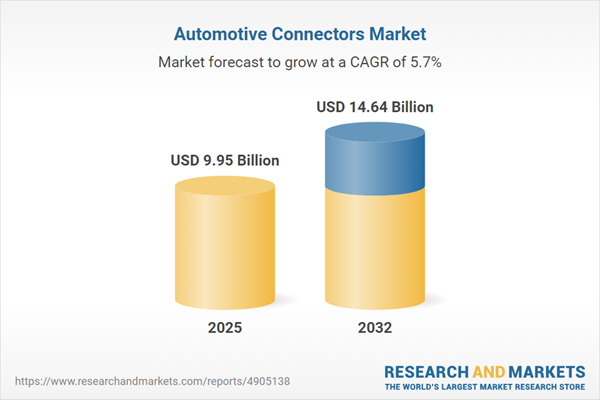Speak directly to the analyst to clarify any post sales queries you may have.
The automotive connectors market is transforming as electrification and advanced vehicle technologies gain momentum, prompting senior leaders to reassess their strategic approach to supply chain, product innovation, and partnerships. This report provides comprehensive, actionable insight for stakeholders seeking effective market positioning in a period of structural change.
Market Snapshot: Automotive Connectors Market Growth
The automotive connectors market grew from USD 9.42 billion in 2024 to USD 9.95 billion in 2025. It is anticipated to continue expanding at a CAGR of 5.66%, reaching USD 14.64 billion by 2032. Market expansion is being driven by the rapid adoption of electric vehicle architectures, autonomous driving features, and the demand for secure, high-speed connectivity solutions within modern automotive ecosystems.
Scope & Segmentation
This report thoroughly examines all dimensions underpinning the automotive connectors landscape to enable data-driven decision-making:
- Product Types: Board To Board, ECU Connectors, Sensor Connectors, Wire To Board, Wire To Wire
- Connector Types: Circular, Coaxial, Rectangular
- Current Ratings: High Current (>50A), Medium Current (5-50A), Low Current (<5A)
- Mounting Types: Free-Hanging, Surface Mount, Through Hole
- Applications: Body Electronics, Chassis, Infotainment (with Audio Systems, Video Systems), Powertrain, Telematics (including Emergency Systems, Vehicle Tracking)
- Vehicle Types: Commercial Vehicles (Heavy, Light), Passenger Cars
- End Users: Aftermarket, OEM
- Regional Analysis: Americas (North America including United States, Canada, Mexico; Latin America including Brazil, Argentina, Chile, Colombia, Peru), Europe Middle East & Africa (covering United Kingdom, Germany, France, Russia, Italy, Spain, Netherlands, Sweden, Poland, Switzerland; UAE, Saudi Arabia, Qatar, Turkey, Israel; South Africa, Nigeria, Egypt, Kenya), Asia-Pacific (China, India, Japan, Australia, South Korea, Indonesia, Thailand, Malaysia, Singapore, Taiwan)
- Key Companies Examined: TE Connectivity Ltd., Yazaki Corporation, Aptiv PLC, Sumitomo Electric Industries, Amphenol Corporation, Lear Corporation, Molex LLC, Japan Aviation Electronics Industry, Rosenberger Hochfrequenztechnik, J.S.T. Mfg. Co.
Key Takeaways for Senior Decision-Makers
- Automotive connectors play a central role in supporting the rapid shift from internal combustion to electric and hybrid powertrains, which is increasing system voltage and data complexity.
- Global regulatory pressures and evolving safety standards are driving material advancements, miniaturization, and integrated design approaches throughout the supply chain.
- Collaboration between connector manufacturers, semiconductor firms, and vehicle OEMs is accelerating innovation cycles and enabling integration of high-function, multi-pin and high-speed interfaces.
- Integrated electronic control units and modular assemblies are simplifying vehicle architectures and promoting the adoption of over-the-air software updates, reducing overall lifecycle costs.
- Strategic investments in smart manufacturing, digital engineering, and advanced quality control are increasingly vital for competitiveness and operational resilience.
- Regional opportunities vary as differing regulatory environments and consumer demands shape technology adoption and market penetration across the Americas, EMEA, and Asia-Pacific.
Tariff Impact: 2025 United States Measures
Revised 2025 US tariff policies are adding complexity and cost to global supply chains. Manufacturers are diversifying suppliers, investing in nearshoring, and building relationships with regional distributors to mitigate volatility, ensure continuity, and respond quickly to shifting conditions. Collaborative planning and digital procurement are strengthening inventory management across the industry.
Methodology & Data Sources
This market analysis is built on a rigorous research framework, drawing from in-depth interviews with engineers and executives, technical white paper reviews, patent analysis, and regulatory documentation. Findings were validated using a triangulation approach and quality-assurance protocols to ensure reliable, actionable insights.
Why This Report Matters
- Enables strategic planning with in-depth segmentation, technology, and regional analysis tailored for B2B automotive leadership.
- Equips decision-makers to anticipate risk and capitalize on supply chain and technology trends impacting future market growth.
- Support for investment and partnership decisions through timely analysis of innovation, alliances, and manufacturing best practices.
Conclusion
Senior leaders in the automotive connectors market can leverage this report to inform key investment, procurement, and innovation strategies. Comprehensive segmentation, regional insights, and trend analysis offer a blueprint for sustaining competitive advantage in a fast-evolving landscape.
Additional Product Information:
- Purchase of this report includes 1 year online access with quarterly updates.
- This report can be updated on request. Please contact our Customer Experience team using the Ask a Question widget on our website.
Table of Contents
3. Executive Summary
4. Market Overview
7. Cumulative Impact of Artificial Intelligence 2025
Companies Mentioned
The companies profiled in this Automotive Connectors market report include:- TE Connectivity Ltd.
- Yazaki Corporation
- Aptiv PLC
- Sumitomo Electric Industries, Ltd.
- Amphenol Corporation
- Lear Corporation
- Molex LLC
- Japan Aviation Electronics Industry, Limited
- Rosenberger Hochfrequenztechnik GmbH & Co. KG
- J.S.T. Mfg. Co., Ltd.
Table Information
| Report Attribute | Details |
|---|---|
| No. of Pages | 185 |
| Published | October 2025 |
| Forecast Period | 2025 - 2032 |
| Estimated Market Value ( USD | $ 9.95 Billion |
| Forecasted Market Value ( USD | $ 14.64 Billion |
| Compound Annual Growth Rate | 5.6% |
| Regions Covered | Global |
| No. of Companies Mentioned | 11 |









